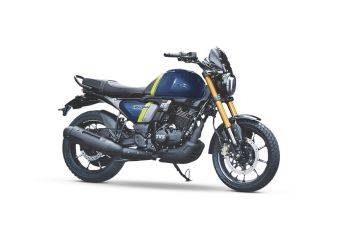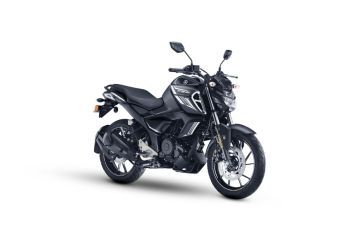Explore all New Cars of 2025
TVS Ronin vs Yamaha FZS-FI V3
Ronin vs FZS-FI V3
| Key Highlights | Ronin SS - Lighting Black | FZS-FI V3 Matte Red And Matte Grey |
|---|---|---|
| Engine Type | Single Cylinder, 4 Stroke, 4 Valve, SOHC | Air cooled, 4-stroke, SOHC, 2-valve |
| Max Power | 20.4 PS @ 7750 rpm | 12.4 PS @ 7250 rpm |
-
TVS Ronin
 Rs. 1.35 Lakh EMI - Rs. 3,889 View February OffersYamaha FZS-FI V3
Rs. 1.35 Lakh EMI - Rs. 3,889 View February OffersYamaha FZS-FI V3 Rs. 1.22 Lakh EMI - Rs. 3,541 View February Offers
Rs. 1.22 Lakh EMI - Rs. 3,541 View February Offers
Ronin vs FZS-FI V3 Key Highlights
| Basic Info | TVS Ronin SS - Lighting Black | Yamaha FZS-FI V3 Matte Red And Matte Grey |
|---|---|---|
| Rating |
197 reviews
|
536 reviews
|
| Brand Name | TVS | Yamaha |
| Ex-Showroom Price | Rs. 1.35 Lakh Check On Road Price | Rs. 1.22 Lakh Check On Road Price |
| Engine Type | Single Cylinder, 4 Stroke, 4 Valve, SOHC | Air cooled, 4-stroke, SOHC, 2-valve |
| Max Power | 20.4 PS @ 7750 rpm | 12.4 PS @ 7250 rpm |
| Fuel Type | Petrol | Petrol |
| Colors | ||
| Brakes Front | Disc | Disc |
| Brakes Rear | Disc | Disc |
| Wheel Size | Front :-431.8 mm,Rear :-431.8 mm | Front :-431.8 mm,Rear :-431.8 mm |
| Wheels Type (Pressed Steel/ Alloy) | Spoke Alloy Wheels | Alloy |
| ABS | Single Channel | Single Channel |
| Starting | Self Start Only | Self Start Only |
| Speedometer | Digital | Digital |
| EMI |
Rs. 3,889
@
9.45% (36 months)
|
Rs. 3,541
@
9.45% (36 months)
|
| Insurance | Rs. 10,960 Ronin Insurance | Rs. 8,960 FZS-FI V3 Insurance |
| Brochure |
Download
Brochure
|
Download
Brochure
|
Engine |
|
|||||||||||||||||||||||||||||||||||||||||||||||||||||||||||||||
|---|---|---|---|---|---|---|---|---|---|---|---|---|---|---|---|---|---|---|---|---|---|---|---|---|---|---|---|---|---|---|---|---|---|---|---|---|---|---|---|---|---|---|---|---|---|---|---|---|---|---|---|---|---|---|---|---|---|---|---|---|---|---|---|---|
Brakes |
|
|||||||||||||||||||||||||||||||||||||||||||||||||||||||||||||||
Performance |
|
|||||||||||||||||||||||||||||||||||||||||||||||||||||||||||||||
Tyres |
|
|||||||||||||||||||||||||||||||||||||||||||||||||||||||||||||||
Dimensions |
|
|||||||||||||||||||||||||||||||||||||||||||||||||||||||||||||||
Electricals |
|
|||||||||||||||||||||||||||||||||||||||||||||||||||||||||||||||
Features |
|
Pros and Cons
- Positives
- Negatives
- Torquey engine ensures you don’t have to shift as frequently
- Excellent fit and finish
- Lightweight and agile in both city traffic and highway
- Can easily accommodate tall riders.
- Big bike styling
- features
- smooth engine.
- Unimpressive highway performance
- You’ll need to pull the front brake lever really hard for aggressive braking
- Performance isn’t up to the mark
- the quality of plastics feels sub-par.
Is TVS Ronin Better Than Yamaha FZS-FI V3?
67% users have chosen TVS Ronin over Yamaha FZS-FI V3 in a survey being conducted on zigwheels.com.
Apart from this survey a total of 1813 users have also rated TVS Ronin and Yamaha FZS-FI V3 on some really important factors like Mileage , performance, comfort, safety etc. and have given their personal opinions about these bikes.
As per the users experiences TVS Ronin is a winner for you if you are seriously looking for maintenance and features in your bike. But Yamaha FZS-FI V3 is better on the grounds of mileage and comfort. On the basis of performance user have rated both the bikes equally.
Before making your decision you should also consider the unbiased and thorough analysis of these bikes on every aspect by our auto experts who have summarised the analysis in pros, cons and final conclusion..
| Ratings Factor | Ronin | FZS-FI V3 |
|---|---|---|
| Mileage | 4.0 | 4.3 |
| Performance | 4.2 | 4.2 |
| Comfort | 4.3 | 4.4 |
| Maintenance | 3.9 | 3.8 |
| Features | 4.5 | 4.3 |
Videos of TVS Ronin and Yamaha FZS-FI V3
-
Royal Enfield Hunter 350 vs TVS Ronin Comparison Review | Distinct Yet Contrasting | Zigwheels.com 8 Sep, 2022 4378 views
-
Two-wheeler Hits And Misses Of 2022 - Royal Enfield Hunter 350, TVS Ronin, KTM RC 390, Ultraviolette F77 29 Dec, 2022 17099 views
-
2022 TVS Ronin First Ride Review | Why And How Did The Zeppelin Cruiser Become #Unscripted? 9 Jul, 2022 9751 views
-
TVS Ronin Complete Accessories And Merchandise Walkaround Video | Make This Retro TVS Even More Unique 6 Jul, 2022 10703 views
-
TVS Ronin Walkaround Video | Is It A Scrambler, Cruiser Or What? | Power, Features And Price Revealed 6 Jul, 2022 6401 views
-
Traction Control For Yamaha FZ-S Fi Version 4.0, FZ-X, R15 M, MT-15 V2 | Price & Features | Zigwheels 14 Feb, 2023 8959 views
TVS Ronin Comparison with Similar Bikes
yamaha fz s fi version 3 Comparison with Similar Bikes
-
 YamahaFZS-FI V3Rs. 1.22 LakhvsFZS-FI V3 vs Apache RTR 160 4V
YamahaFZS-FI V3Rs. 1.22 LakhvsFZS-FI V3 vs Apache RTR 160 4V TVSApache RTR 160 4VRs. 1.24 Lakh
TVSApache RTR 160 4VRs. 1.24 Lakh -
 YamahaFZS-FI V3Rs. 1.22 LakhvsFZS-FI V3 vs FZ-FI Version 3.0
YamahaFZS-FI V3Rs. 1.22 LakhvsFZS-FI V3 vs FZ-FI Version 3.0 YamahaFZ-FI Version 3.0Rs. 1.17 Lakh
YamahaFZ-FI Version 3.0Rs. 1.17 Lakh
Latest News on TVS Ronin and Yamaha FZS-FI V3
-
 Modified TVS Ronins At Auto Expo 2025: From a Cafe Race To A Flat Tracker & More19 Jan, 2025 | By Team ZigWheels
Modified TVS Ronins At Auto Expo 2025: From a Cafe Race To A Flat Tracker & More19 Jan, 2025 | By Team ZigWheels -
 Yamaha Announces Festive Offers For FZ-Fi, FZ-S Fi V3 and V4, Fascino And RayZR 125 Fi Hybrid26 Sep, 2024 | By Team ZigWheels
Yamaha Announces Festive Offers For FZ-Fi, FZ-S Fi V3 and V4, Fascino And RayZR 125 Fi Hybrid26 Sep, 2024 | By Team ZigWheels -
 2025 TVS Ronin DS Variant Unveiled at TVS MotoSoul 20247 Dec, 2024 | By Team ZigWheels
2025 TVS Ronin DS Variant Unveiled at TVS MotoSoul 20247 Dec, 2024 | By Team ZigWheels -
 Yamaha FZ-S FI V4 vs TVS Apache RTR 160: Features Compared20 Feb, 2023 | By Team ZigWheels
Yamaha FZ-S FI V4 vs TVS Apache RTR 160: Features Compared20 Feb, 2023 | By Team ZigWheels -
 TVS Ronin Drift R School Launched: Now You Can Learn Flat Tracking On A Ronin!20 Nov, 2024 | By Team ZigWheels
TVS Ronin Drift R School Launched: Now You Can Learn Flat Tracking On A Ronin!20 Nov, 2024 | By Team ZigWheels -
 Yamaha FZ-S V4 Vs FZ-S V3: New Vs Old In 5 Pics13 Feb, 2023 | By Team ZigWheels
Yamaha FZ-S V4 Vs FZ-S V3: New Vs Old In 5 Pics13 Feb, 2023 | By Team ZigWheels -
 TVS Ronin Colours Explained: Which One Is For You?26 Sep, 2024 | By Team ZigWheels
TVS Ronin Colours Explained: Which One Is For You?26 Sep, 2024 | By Team ZigWheels -
 Alcohol-guzzling Bikes Showcased at Auto Expo13 Jan, 2023 | By Team ZigWheels
Alcohol-guzzling Bikes Showcased at Auto Expo13 Jan, 2023 | By Team ZigWheels -
 TVS Ronin Midnight Blue Colour Option Launched; Base Variant Price Dropped25 Sep, 2024 | By Team ZigWheels
TVS Ronin Midnight Blue Colour Option Launched; Base Variant Price Dropped25 Sep, 2024 | By Team ZigWheels -
 Key Highlights Of The 2022 Yamaha FZ-S Version 3.05 Jan, 2022 | By Team ZigWheels
Key Highlights Of The 2022 Yamaha FZ-S Version 3.05 Jan, 2022 | By Team ZigWheels
Recently Asked User Questions
- My experience yamaha fzs fi v3 very good
- Both bike are good but according to my experience FZ s bike is so good
- Yamaha FZ s
- Both the bikes are good in their forte. In nearly every aspect, except maybe ergonomics and braking, the Yamaha FZS-FI v3.0 fails to impress. While its motor offers better fuel efficiency compared to the previous-gen model, it lacks grunt. If you have around Rs 1 lakh to invest, you're better off with say a TVS Apache RTR 160 4V, Bajaj Pulsar NS 160 or the Suzuki Gixxer. Whereas, the Yamaha MT 15 BS6 is more than just the R15 v3 sans fairing. The naked looks sharp is light and can be a hoot to commute. However, the compact riding posture might be a bit too tight for large riders. What is also disheartening is the poor switchgear and build quality as well as the lack of dual-channel ABS. Moreover, we would suggest you to take a test ride for a better understanding of performance and comfort. Click on the link and select your desired city for dealership details.
- Selecting the right bike would depend on several factors such as your budget preference on the segment, features required, engine options, brand preference, etc. In nearly every aspect, except maybe ergonomics and braking, the Yamaha FZS-FI v3.0 fails to impress. While its motor offers better fuel efficiency compared to the previous-gen model, it lacks grunt. If you have around Rs 1 lakh to invest, you're better off with say a TVS Apache RTR 160 4V, Bajaj Pulsar NS 160, or the Suzuki Gixxer. Yamaha FZS-FI V3 is powered by a 149 cc engine. This FZS-FI V3 engine generates a power of 12.4 PS @ 7250 rpm and a torque of 13.3 Nm @ 5500 rpm. The claimed mileage of FZS-FI V3 is 55.42 kmpl. On the other hand, The TVS Apache RTR 160 4V has been the benchmark when it comes to 160cc motorcycles. With the BS6-compliant iteration, TVS has made sure it is still as sprightly, with the '21 update making it the most powerful bike in the 160cc sporty commuter class. The overall package and reasonable pricing make it a true value-for-money motorcycle in its segment. TVS Apache RTR 160 4V is powered by a 159.7 cc engine. This Apache 160 4V engine generates a power of 17.63 PS @ 9250 rpm and a torque of 14.73 Nm @ 7250 rpm. Moreover, we would suggest you to take a test ride before making the final decision. Follow the link and select your desired city for dealership.
















